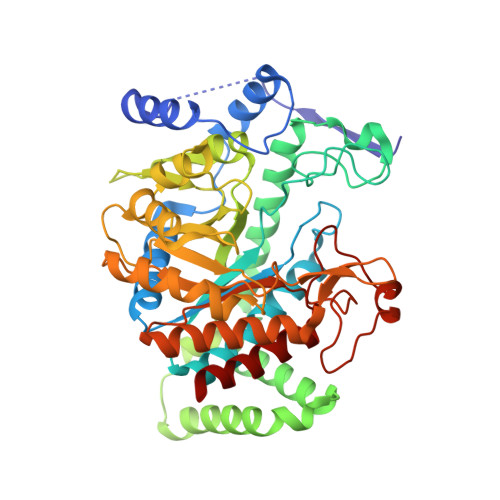Dynamic cross-talk among remote binding sites: the molecular basis for unusual synergistic allostery.
Jiao, W., Hutton, R.D., Cross, P.J., Jameson, G.B., Parker, E.J.(2012) J Mol Biol 415: 716-726
- PubMed: 22154807
- DOI: https://doi.org/10.1016/j.jmb.2011.11.037
- Primary Citation of Related Structures:
3RZI - PubMed Abstract:
Allosteric regulation of protein function is critical for metabolic control. Binding of allosteric effectors elicits a functional change in a remote ligand binding site on a protein by altering the equilibrium between different forms in the protein ensemble. 3-Deoxy-d-arabino-heptulosonate 7-phosphate synthase (DAH7PS) catalyzes the first step in the shikimate pathway, which is responsible for the biosynthesis of aromatic amino acids Trp, Phe, and Tyr. Feedback regulation by the aromatic amino acids is important for controlling the cellular levels of the aromatic amino acids, and many organisms have two or more DAH7PS isozymes that show differing sensitivities to aromatic compounds. Mycobacterium tuberculosis expresses a single DAH7PS that is insensitive to the presence of a single amino acid yet shows extraordinary synergistic inhibition by combinations of the pathway end products Trp and Phe. The Trp+Phe-bound structure for M. tuberculosis DAH7PS, showing two separate binding sites occupied by Trp and Phe for each monomer of the tetrameric protein, was obtained by cocrystallization. Comparison of this structure with the ligand-free M. tuberculosis DAH7PS demonstrates that there is no significant change in conformation upon ligand binding, suggesting that contributions from altered dynamic properties of the enzyme may account for the allosteric inhibition. Isothermal titration calorimetry experiments demonstrate that the inhibitor binding sites are in direct communication. Molecular dynamics simulations reveal different changes in dynamic fluctuations upon single ligand binding compared to dual ligand binding. These changes account for the cross-talk between inhibitor binding sites and the active site, simultaneously potentiating both dual ligand binding and diminution of catalytic function.
Organizational Affiliation:
Biomolecular Interaction Centre, Department of Chemistry, University of Canterbury, Christchurch, New Zealand.





















